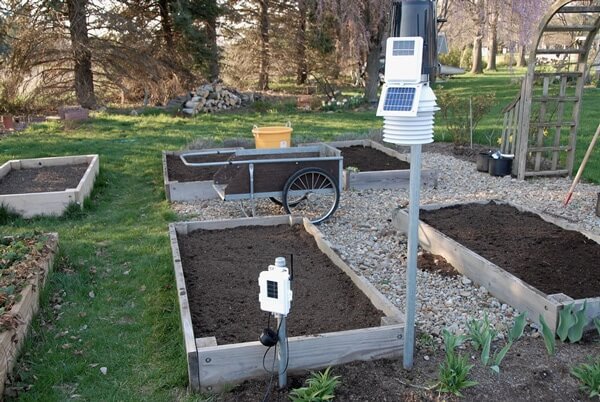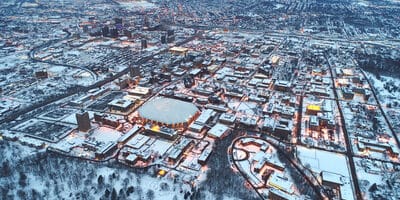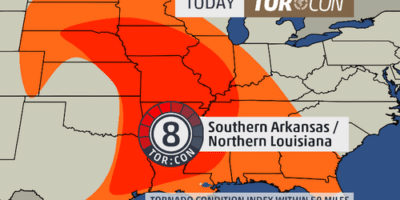
Davis Instruments Vantage Pro2 weather station
A weather station is a collection of instruments that measure atmospheric conditions to help study the weather and climate of a specific location. Most weather stations will measure temperature, humidity, barometric pressure, wind speed and direction, and rainfall.
An official weather station is used for aviation, military, and meteorological purposes, while personal home weather stations are for private or, in some cases, research use. Weather enthusiasts, farmers, and schools are the most common owners of personal weather stations.
Official Weather Stations
There are three types of official weather monitoring systems in use in the United States, ATIS, AWOS, and ASOS.
- ATIS stands for Automated Terminal Information Service and requires a human to monitor the system from the airport tower. ATIS reports are attached to ASOS data. They are written by a human and describe the weather conditions. They’re typically released at 55 past the hour, and more often as conditions warrant.
- ASOS stands for Automated Surface Observing System. It is operated by the Department of Defense, National Weather Service, and the Federal Aviation Administration. Most FAA airports use AWOS, short for Automated Weather Observing System, but it is essentially the same system.

Automated Surface Observing System (ASOS) at Ronald Reagan Washington National Airport in Arlington County, Virginia
There are other names for these systems in other countries. Most developed nations use a similar platform to standardize meteorological observations, and the same format to report them, called METAR (METeorological Aerodrome Reports).
There are different models of official weather stations, but the most complex will report all the following observations in addition to basic observations:
- Sky condition, cloud height and amount up to 12,000 feet
- Visibility
- Present weather conditions, including precipitation type and obstructions like fog, haze, and smoke
- Selected significant remarks, including variable cloud height, variable visibility, precipitation beginning/ending times, rapid pressure changes, pressure change tendency, wind shift, peak wind
The data compiled by official weather stations are used by meteorologists to help in creating forecasts, and they are shared through the Internet and other sources. The data is especially useful for computerized weather models to help meteorologists better predict the weather.
Personal Weather Stations

Ambient Weather WS-2902C weather station
Personal weather stations are nowhere near as complex and don’t have the degree of accuracy that official weather stations do. However, more expensive models are capable enough to be used in research applications. Most will report on temperature, humidity, barometric pressure, wind speed and direction, and rainfall.
Some stations offer additional sensors that are useful for specific applications. Lightning and UV/light sensors might be helpful for those who participate in outdoor activities frequently, and soil moisture and leaf moisture sensors are useful for gardeners and farmers.
Personal stations are often connected to the Internet to share data and monitor conditions remotely through platforms such as Weather Underground and Ambient Weather Network. Their measurements can also trigger smart home devices.
Meteorologists will even use the data from personal stations. Private stations can fill in the gaps where official weather stations aren’t. The Cooperative Weather Observer Program (CWOP) is a network of weather stations from volunteers that share weather observations from their stations with the NWS.
How Much Does A Weather Station Cost?
The most popular brands of home weather stations include AcuRite, Ambient Weather, Davis Instruments, and La Crosse Technology. Generally, the price increases with additional functionality and more accuracy.
Basic models cost as little as $40, but these have limited functionality and typically will only measure indoor/outdoor temperature, humidity, and barometric pressure. We refer to these models as an indoor outdoor thermometer.
Mid-grade stations range from $100-$300, along with temperature, humidity, and barometric pressure, they will also include rainfall and wind measurements and the ability to connect to the Internet. Some models in this price range also have specialized sensors, such as UV and solar radiation, or a lightning detector. A mid-grade station we recommend is the Ambient Weather WS-2902C.
Professional-grade home weather stations start at approximately $500 and can cost thousands when upgraded with additional sensors. They are far more accurate and durable than their counterparts. The anemometer on pro stations is separate from the main sensor housing for optimal sensor placement, which increases the accuracy of readings. Professional grade stations include specialized models and accurate sensors designed for research purposes and farming, such as the Davis Instruments Vantage Pro2.
Why Do You Need a Weather Station?
A weather station can help you prepare for the weather ahead and offer localized and sometimes more accurate reports than a weather app that may be receiving data from a station that is miles away from your location. We’ve listed some of the potential reasons why a weather station may be useful below.
- Use it to learn more about the weather and climate where you live.
- You live in a remote area without an official weather station nearby.
- You’re a gardener or farmer and need to know when to plant and harvest.
- You can trigger smart home devices with the data.
- If your business is weather-dependent, you can optimize your business to operate more efficiently according to the observed weather conditions.
Types of Sensors on a Weather Station

AcuRite Atlas weather station cutaway diagram
Most commonly, you’ll find the following instruments in a weather station.
Thermometer
A thermometer measures the temperature of the air around the station. Most weather stations have two thermometers, one inside the display console to record indoor temperature, and one in the sensor housing for outdoor temperature, as shown in the picture above.
Hygrometer
A hygrometer measures the amount of moisture in the air, known as humidity. Again, most weather stations will also have two of these, one in the display console and the other in the sensor housing.
Anemometer
An anemometer measures wind speed. There are two methods most commonly used. One measures wind through rotations of a cupped apparatus on the sensor housing, another that uses sonic technology to measure wind passing through an opening in the instrument itself.
Wind Vane
A wind vane measures the direction of winds. The vane points in the direction the wind is blowing from. Sonic anemometers can also detect the direction of wind using the same concepts it does to measure wind speed.
Barometer
The barometer measures atmospheric pressure and is a crucial forecasting tool. It is typically located within the console or a recording device inside the home. Downward pressure changes usually indicate stormier weather, while rising pressure precedes improving weather conditions.
Rain Gauge
The rain gauge measures how much rain has fallen. The most common method is a tipping bucket gauge. This gauge uses a funnel that collects rainfall, which empties onto small buckets that tip back and forth once a specific weight of water is obtained, typically equivalent to 0.01 inches. Ultra-modern weather stations are now employing other technologies, including haptics, to detect precipitation more precisely. However, analog rain gauges are still more precise. We even ranked an analog model as the most accurate rain gauge in our buying guide.
UV and Solar Radiation Sensor
The UV and solar radiation sensors measure ultraviolet radiation and solar radiation and are useful for outdoor activities and applications like smart homes.
Lightning Detector
A lightning detector can sense lightning within about 25 miles of your location. Some are also capable of calculating the direction of the storm’s movement, although that’s less common.
Leaf Wetness Sensor
The leaf wetness sensor approximates the amount of surface moisture on foliage, aiding in gardening and farming.
Soil Moisture Sensor
A soil moisture sensor detects the amount of available moisture in the soil. Some can also record soil temperature. These sensors are necessary for irrigation decisions for successful farming and gardening.
Air Quality Sensors
With many consumers increasingly concerned about pollution, some weather station manufacturers now include the option to add air quality sensors to higher-end models to measure particulate matter.
Uses for Weather Stations
Weather stations are used for various reasons, not solely for meteorology or aviation purposes. Here are some examples of potential applications.

Davis Pro2 weather station with a soil moisture sensor for gardening
Agriculture and Gardening
Weather station data can be handy for gardening and farming. By knowing the temperature, you will be able to protect plants from harsh conditions, and by understanding the soil moisture, humidity, and rainfall, you can optimize watering for higher yields.
Industry
Many industries can benefit from weather data. Water treatment plants use rainfall data to plan better for expected high flows. At the same time, construction industries might find temperature and humidity data useful in applications where certain conditions are necessary, like roadwork and concrete laying.
Education
Weather stations are great educational tools. Science educators might find a weather station useful for showing real-world examples of topics taught in class.
Airports
The airline industry business is affected by weather continuously. Winds play a significant role in safe takeoffs and landings, and poor weather conditions prevent planes from taking off. That’s why a large portion of ASOS stations are located at airports.
Research
Researchers can quickly deploy small weather stations to conduct research. Some storm chasers use the scale of the TORCON Index and install weather stations on their cars to take measurements in storms.
Weather Enthusiasts
If you find the weather fascinating, you should own a weather station yourself. You’ll be able to share and compare data with other stations nearby, and you can learn more about the weather around your home.
Smart Homes
Some internet-connected weather stations can connect to third-party services, and their data can be used to trigger smart home devices. For example, your smart water sprinkler system could shut itself off when it starts raining, or your lights could be triggered to turn on when the sunlight drops to a certain level.
Daily Life
You don’t need to have a specific use for a weather station at all. We think that just about anyone could find ownership beneficial, whether it’s to help you dress more appropriately for the conditions, to better plan for outdoor activities, or to gain a better understanding of weather systems.
Weather Station Installation and Maintenance Tips
Weather stations are easy to install and maintain. While we’ve already posted comprehensive guides on where to install a weather station and weather station maintenance, the most important tips are listed below.
Weather Station Installation
Follow these tips to get the best results from your weather station.
- Place your thermometer and humidity sensors at eye level, roughly six feet off the ground.
- Your anemometer and wind vane should be in an unobstructed area and as high as possible. Official readings are taken at 33 feet.
- Place your rain gauge at least 4-6 feet off the ground.
- Most modern personal weather stations will combine the temperature, humidity, and rain gauge into one unit. If you have an all-in-one sensor suite, you will have to compromise on each component’s ideal height. Ten feet or higher is perfect.
- Make sure it is also in an open area. A good rule of thumb is to place your sensors in a location of at least three to four times the height of nearby obstructions.
Weather Station Maintenance
These tips will help you maintain the accuracy of your station, and extend its usable life.
- Monitor your sensors for signs of inaccurate readings. Using a nearby official station may help you to do this. Recalibrate your sensors regularly, if necessary.
- Regularly inspect the site where you install your station for issues, including loose parts, signs of damage or wear, or problems with your mounting hardware.
- Most higher-end sensor suites can be disassembled for cleaning. We recommend a seasonal inspection and cleaning. Refer to your user manual for instructions specific to your station.
- Change any batteries at least once a year, and preferably before the winter months.
Wrapping Up
We hope that this overview has helped answer any questions that you may have had on weather stations. While you’re here, we recommend you check out our weather station buying guide to help you find the best home weather station. We’ve reviewed quite a few models in detail, so if you’re in the market, we recommend reading our reviews before making a purchase.
If you are more of a visual learner, check out our infographic below, which illustrates the information in this article.





